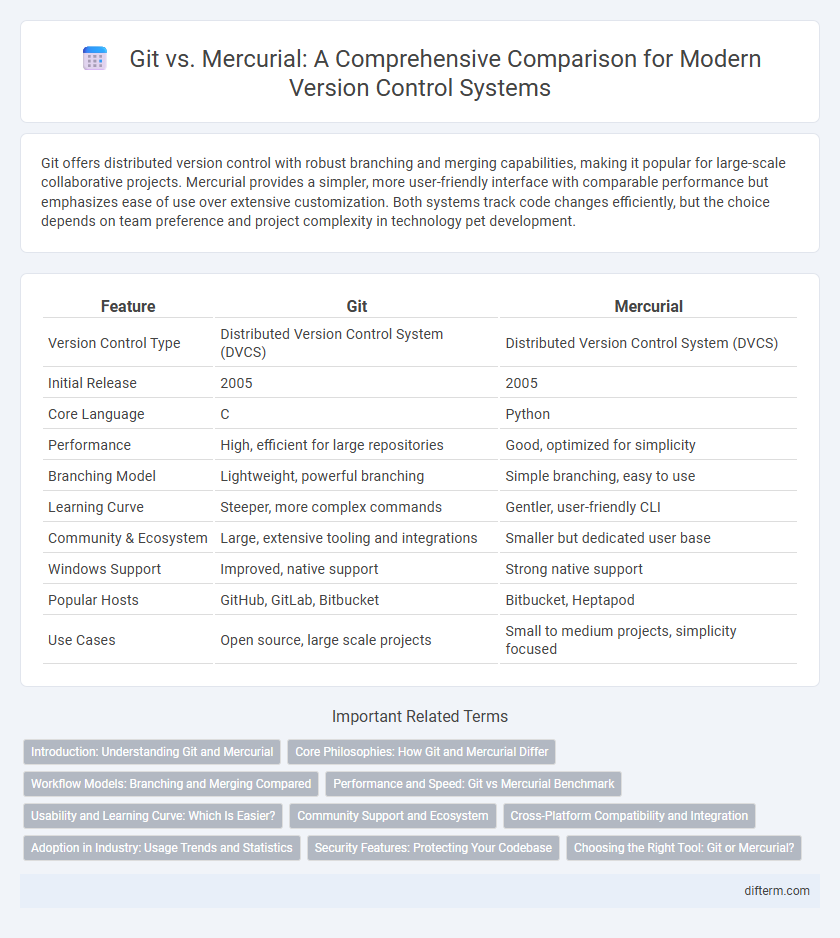Git offers distributed version control with robust branching and merging capabilities, making it popular for large-scale collaborative projects. Mercurial provides a simpler, more user-friendly interface with comparable performance but emphasizes ease of use over extensive customization. Both systems track code changes efficiently, but the choice depends on team preference and project complexity in technology pet development.
Table of Comparison
| Feature | Git | Mercurial |
|---|---|---|
| Version Control Type | Distributed Version Control System (DVCS) | Distributed Version Control System (DVCS) |
| Initial Release | 2005 | 2005 |
| Core Language | C | Python |
| Performance | High, efficient for large repositories | Good, optimized for simplicity |
| Branching Model | Lightweight, powerful branching | Simple branching, easy to use |
| Learning Curve | Steeper, more complex commands | Gentler, user-friendly CLI |
| Community & Ecosystem | Large, extensive tooling and integrations | Smaller but dedicated user base |
| Windows Support | Improved, native support | Strong native support |
| Popular Hosts | GitHub, GitLab, Bitbucket | Bitbucket, Heptapod |
| Use Cases | Open source, large scale projects | Small to medium projects, simplicity focused |
Introduction: Understanding Git and Mercurial
Git is a widely-used distributed version control system designed for speed and efficiency in managing large codebases, while Mercurial offers a similarly distributed approach with a simpler, more user-friendly interface focused on ease of use and performance. Both tools enable developers to track changes, collaborate on code, and manage project history, but Git's extensive branching and merging capabilities have made it the industry standard. Understanding the core functionalities, command structures, and community support of Git and Mercurial is crucial for selecting the right version control system for software development projects.
Core Philosophies: How Git and Mercurial Differ
Git emphasizes distributed version control with a focus on branching and merging, allowing developers to work independently and integrate changes efficiently. Mercurial prioritizes simplicity and ease of use, offering a more streamlined and user-friendly interface suited for straightforward workflows. Both systems manage source code but diverge in their core philosophies, with Git providing advanced flexibility and Mercurial emphasizing accessibility and consistency.
Workflow Models: Branching and Merging Compared
Git employs a flexible branching model that enables lightweight, fast creation and deletion of branches, making parallel development and feature isolation efficient. Mercurial uses a simpler branching approach with named branches or bookmarks, which can be less intuitive but maintains a more linear history. When merging, Git supports complex scenarios with extensive conflict resolution tools, whereas Mercurial emphasizes straightforward merging with a focus on preserving clear and readable project history.
Performance and Speed: Git vs Mercurial Benchmark
Git demonstrates superior performance in handling large repositories and complex branching compared to Mercurial, thanks to its efficient delta storage and packfile mechanisms. Benchmark tests reveal that Git executes commit and merge operations faster, enhancing developer productivity in extensive projects. However, Mercurial's speed remains competitive in smaller repositories, benefiting user scenarios where simpler workflows are prioritized.
Usability and Learning Curve: Which Is Easier?
Git offers a steeper learning curve due to its complex branching model and extensive feature set, but it provides more powerful version control capabilities for advanced users. Mercurial features a simpler, more intuitive interface and consistent command structure, making it easier for beginners to grasp and use effectively. For teams prioritizing ease of use and quick onboarding, Mercurial often proves more accessible, whereas Git's complexity is balanced by its widespread adoption and robust ecosystem.
Community Support and Ecosystem
Git offers a significantly larger community support and a more extensive ecosystem compared to Mercurial, with millions of active users and thousands of integrations. Platforms like GitHub and GitLab enhance Git's ecosystem by providing collaborative tools, CI/CD pipelines, and extensive plugin libraries. Mercurial, while reliable and simpler for certain workflows, has a smaller user base and fewer third-party resources, limiting its community-driven development and support options.
Cross-Platform Compatibility and Integration
Git offers extensive cross-platform compatibility, functioning seamlessly on Windows, macOS, and Linux, with robust integration across popular IDEs and continuous integration tools. Mercurial also supports multiple operating systems and features a straightforward integration process, particularly excelling in enterprise environments with custom workflows. Both version control systems provide reliable cross-platform solutions, but Git's broader community support ensures wider compatibility and plugin availability.
Adoption in Industry: Usage Trends and Statistics
Git dominates the version control market with over 80% adoption among software development teams, driven by its strong integration with platforms like GitHub and GitLab. Mercurial, while appreciated for simplicity and performance, holds a smaller niche, primarily in legacy projects and certain enterprise environments. Industry reports indicate Git's continuous growth due to widespread community support and robust ecosystem tools, overshadowing Mercurial's more limited adoption trends.
Security Features: Protecting Your Codebase
Git employs cryptographic hashing with SHA-1 or SHA-256 to ensure the integrity and authenticity of commits, making it difficult for attackers to alter history without detection. Mercurial also uses SHA-1 hashes for commit verification but includes additional security settings like signed commits and extensions that enhance access control. Both systems support encrypted transport protocols such as SSH and HTTPS to protect data during transmission, with Git offering more extensive integration with third-party security tools for code signing and vulnerability scanning.
Choosing the Right Tool: Git or Mercurial?
Git offers superior branching and merging capabilities, making it ideal for large, complex projects with multiple collaborators. Mercurial provides a simpler, more user-friendly interface that can streamline version control for smaller teams or those new to distributed systems. Evaluating project scale, team expertise, and workflow preferences is essential when choosing between Git and Mercurial.
Git vs Mercurial Infographic

 difterm.com
difterm.com